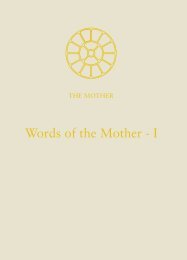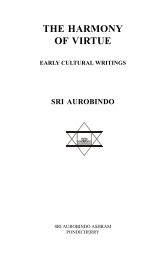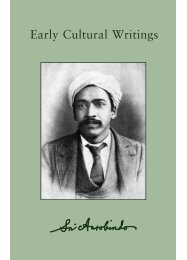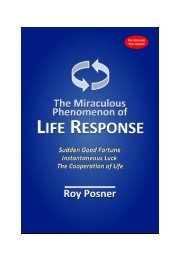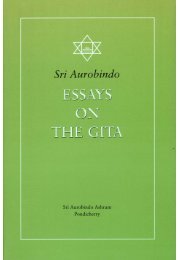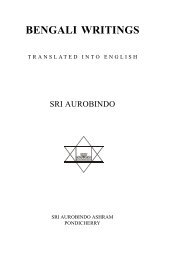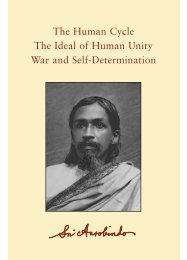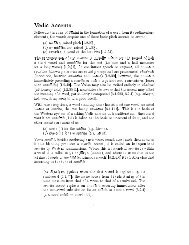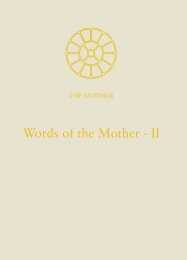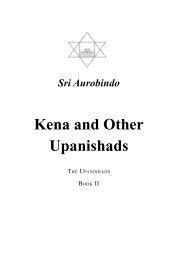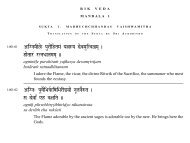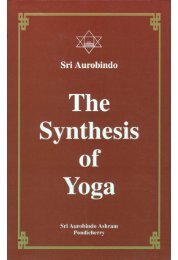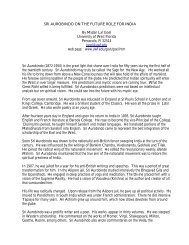- Page 2 and 3: Eleven Talks at AurovillePreparingf
- Page 4 and 5: Tableof ContentsForeword1 Adam Kadm
- Page 6 and 7: able version of the spoken word. Ea
- Page 8 and 9: 1Adam Kadmonand the EvolutionThe Co
- Page 12 and 13: adam kadmon and the evolution 5the
- Page 14 and 15: adam kadmon and the evolution 7true
- Page 16 and 17: adam kadmon and the evolution 9our
- Page 18 and 19: adam kadmon and the evolution 11has
- Page 20 and 21: adam kadmon and the evolution 13mea
- Page 22 and 23: adam kadmon and the evolution 15min
- Page 24 and 25: adam kadmon and the evolution 17vis
- Page 26 and 27: adam kadmon and the evolution 19evo
- Page 28 and 29: adam kadmon and the evolution 21wel
- Page 30 and 31: adam kadmon and the evolution 23Add
- Page 32 and 33: 26 eleven talkshad to make, the bat
- Page 34 and 35: 28 eleven talksexperiences and the
- Page 36 and 37: 30 eleven talks“Secondly, there i
- Page 38 and 39: 32 eleven talksand his Livre des es
- Page 40 and 41: 34 eleven talkstheir world, and the
- Page 42 and 43: 36 eleven talksand all kinds of man
- Page 44 and 45: 38 eleven talksto develop, for cond
- Page 46 and 47: 40 eleven talkson the verge of anot
- Page 48 and 49: 42 eleven talksWhere Being slept un
- Page 50 and 51: 44 eleven talkswhose conscious co-o
- Page 52 and 53: 46 eleven talksnoxious, culturally
- Page 54 and 55: 48 eleven talksIn recent times, how
- Page 56 and 57: 50 eleven talksof the life-world an
- Page 58 and 59: 52 eleven talkswhich went through c
- Page 60 and 61:
54 eleven talksbetween the mental a
- Page 62 and 63:
56 eleven talksthe Inconscient from
- Page 64 and 65:
58 eleven talksThe ship from the ne
- Page 66 and 67:
60 eleven talkschanged the standpoi
- Page 68 and 69:
62 eleven talkstaking the appearanc
- Page 70 and 71:
64 eleven talksand on waking up thi
- Page 72 and 73:
66 eleven talksNonetheless one has
- Page 74 and 75:
68 eleven talksHumanity has to re-a
- Page 76 and 77:
4What Arjuna saw:the Dark Side of t
- Page 78 and 79:
what arjuna saw: the dark side of t
- Page 80 and 81:
what arjuna saw: the dark side of t
- Page 82 and 83:
what arjuna saw: the dark side of t
- Page 84 and 85:
what arjuna saw: the dark side of t
- Page 86 and 87:
what arjuna saw: the dark side of t
- Page 88 and 89:
what arjuna saw: the dark side of t
- Page 90 and 91:
what arjuna saw: the dark side of t
- Page 92 and 93:
what arjuna saw: the dark side of t
- Page 94 and 95:
what arjuna saw: the dark side of t
- Page 96 and 97:
what arjuna saw: the dark side of t
- Page 98 and 99:
52012 and 1956: Doomsday?The Iron A
- Page 100 and 101:
2012 and 1956: Doomsday? 95cosmic c
- Page 102 and 103:
2012 and 1956: Doomsday? 97the chan
- Page 104 and 105:
2012 and 1956: Doomsday? 99New Age
- Page 106 and 107:
2012 and 1956: Doomsday? 101revolut
- Page 108 and 109:
2012 and 1956: Doomsday? 103his arg
- Page 110 and 111:
2012 and 1956: Doomsday? 105are no
- Page 112 and 113:
2012 and 1956: Doomsday? 107On anot
- Page 114 and 115:
2012 and 1956: Doomsday? 109Paleoan
- Page 116 and 117:
2012 and 1956: Doomsday? 111“In t
- Page 118 and 119:
2012 and 1956: Doomsday? 113as a co
- Page 120 and 121:
2012 and 1956: Doomsday? 115terribl
- Page 122 and 123:
118 eleven talksthe peril of gross
- Page 124 and 125:
120 eleven talksin our societies be
- Page 126 and 127:
122 eleven talksOut of the original
- Page 128 and 129:
124 eleven talksvalidation of matte
- Page 130 and 131:
126 eleven talksvalue of any theory
- Page 132 and 133:
128 eleven talksshowed mathematical
- Page 134 and 135:
130 eleven talksthe Sun. For in thi
- Page 136 and 137:
132 eleven talksout the theory of e
- Page 138 and 139:
134 eleven talksIt is now increasin
- Page 140 and 141:
136 eleven talksevolving from order
- Page 142 and 143:
138 eleven talksnothing’ courtesy
- Page 144 and 145:
140 eleven talksEarth specialAs we
- Page 146 and 147:
142 eleven talkssupernatural body t
- Page 148 and 149:
144 eleven talksthoughts, feelings,
- Page 150 and 151:
7Bridges across the Afterlife 1In 1
- Page 152 and 153:
idge across the afterlife 149protec
- Page 154 and 155:
idge across the afterlife 151intoxi
- Page 156 and 157:
idge across the afterlife 153years.
- Page 158 and 159:
idge across the afterlife 155The 19
- Page 160 and 161:
idge across the afterlife 157In Jan
- Page 162 and 163:
idge across the afterlife 159uncoun
- Page 164 and 165:
idge across the afterlife 161has be
- Page 166 and 167:
idge across the afterlife 163Rememb
- Page 168 and 169:
idge across the afterlife 165The Mo
- Page 170 and 171:
idge across the afterlife 167Some s
- Page 172 and 173:
idge across the afterlife 169longer
- Page 174 and 175:
8Sri Aurobindo’sDescent into Deat
- Page 176 and 177:
sri aurobindo’s descent into deat
- Page 178 and 179:
sri aurobindo’s descent into deat
- Page 180 and 181:
sri aurobindo’s descent into deat
- Page 182 and 183:
sri aurobindo’s descent into deat
- Page 184 and 185:
sri aurobindo’s descent into deat
- Page 186 and 187:
sri aurobindo’s descent into deat
- Page 188 and 189:
sri aurobindo’s descent into deat
- Page 190 and 191:
sri aurobindo’s descent into deat
- Page 192 and 193:
sri aurobindo’s descent into deat
- Page 194 and 195:
192 eleven talkscatholic affirmatio
- Page 196 and 197:
194 eleven talksThe Big BangTwo mon
- Page 198 and 199:
196 eleven talksimproving or worsen
- Page 200 and 201:
198 eleven talksAccording to the cu
- Page 202 and 203:
200 eleven talksgoing off under a c
- Page 204 and 205:
202 eleven talksitself in spiritual
- Page 206 and 207:
204 eleven talksuniverse. And Halto
- Page 208 and 209:
206 eleven talksand it is only beca
- Page 210 and 211:
208 eleven talksdetail, slowly and
- Page 212 and 213:
210 eleven talksthe beginning of ne
- Page 214 and 215:
212 eleven talksChild arose. Once h
- Page 216 and 217:
214 eleven talksThe ProblemThe intr
- Page 218 and 219:
216 eleven talksFor we cannot suppo
- Page 220 and 221:
218 eleven talksexistence far excee
- Page 222 and 223:
220 eleven talksstandpoint applies
- Page 224 and 225:
222 eleven talksOmega. Brahman is t
- Page 226 and 227:
224 eleven talksthe cosmic consciou
- Page 228 and 229:
226 eleven talksto return to its Or
- Page 230 and 231:
228 eleven talksall was Darkness an
- Page 232 and 233:
230 eleven talksyet once manifestat
- Page 234 and 235:
232 eleven talksone of his bouts of
- Page 236 and 237:
11The Kalki AvatarGod must be born
- Page 238 and 239:
the kalki avatar 237In the effort t
- Page 240 and 241:
the kalki avatar 239The same point
- Page 242 and 243:
the kalki avatar 241any of these or
- Page 244 and 245:
the kalki avatar 243inconscience, h
- Page 246 and 247:
the kalki avatar 245Asura forces. T
- Page 248 and 249:
the kalki avatar 247have to plunge
- Page 250 and 251:
the kalki avatar 249“It is a ques
- Page 252 and 253:
the kalki avatar 251birth on the va
- Page 254 and 255:
the kalki avatar 253Sri Aurobindo o
- Page 256 and 257:
the kalki avatar 255Let us choose t
- Page 258 and 259:
the kalki avatar 257the Second Worl
- Page 260 and 261:
the kalki avatar 259century CE has
- Page 262 and 263:
the kalki avatar 261Sri Aurobindo a
- Page 264 and 265:
the kalki avatar 263“Krishna open
- Page 266 and 267:
the kalki avatar 2651950 Shri Krish
- Page 268 and 269:
Biographical NoteGeorges Van Vrekhe
- Page 270:
Georges Van Vrekhem, a Belgian Flem



